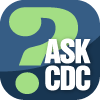Mask and Respirator Usage
[Announcer] This podcast is presented by the Centers for Disease Control and Prevention. CDC – safer, healthier people.
Welcome to Ask CDC, the weekly podcast that answers your questions. I'm your host, Susan Laird.
We're still receiving a lot of questions related to the novel H1N1 flu outbreak. The question we'll answer today is what should I know about using facemasks or respirators related to the novel H1N1 flu outbreak?
First, let's talk about the difference between facemasks and respirators. Facemasks are loose-fitting masks that cover the nose and mouth, such as surgical, dental, and laser masks. Facemasks help stop droplets from being spread by the person wearing them. They also keep splashes or sprays from reaching the mouth and nose of the person wearing a facemask. They are not designed to protect you against breathing in very small particles.
A respirator, on the other hand, is designed to protect you from breathing in very small particles- some of which might contain viruses. They fit tightly to the face so that most air is inhaled through filter material. To work most effectively, respirators must be specially fitted for each person who wears one. N95 disposable respirators are most commonly used in construction and other jobs that involve dust and small particles. Compared with a facemask, it's harder to breathe through an N95 mask for long periods of time.
The main way that influenza viruses are spread is from person-to-person in respiratory droplets from coughs and sneezes. They can also be spread when a person touches respiratory droplets on another person or object and then touches their own mouth or nose, or someone else's mouth or nose, before washing their hands. Although you should avoid close contact with a person who is sick with the flu, this might not be possible if you live with or have to care for that person. Here are a few things to keep in mind when you’re around a person who's sick with the flu:
• If the sick person needs to leave home or can’t stay in a room separate from the common areas of the house, ask them to wear a facemask.
• Avoid being face-to-face with the sick person as much as possible. If you must have close contact with them, for example, holding a sick infant or helping someone take medication or respiratory treatments, wear a facemask or an N95 disposable respirator.
• If you're caring for someone who is sick with the flu, be sure to wear a facemask whenever you leave home to keep from spreading the flu to others.
• And finally, after you take off a facemask or N95 respirator, clean your hands with soap and water or an alcohol-based hand rub.
Facemasks and respirators can be purchased at a pharmacy or a building supply or hardware store. Disposable facemasks and N95 respirators should only be used once. Used facemasks and N95 respirators should be taken off and placed immediately in the trash so they don't touch anything else. Reusable fabric facemasks should be washed with normal laundry detergent and tumble-dried in a hot dryer.
For up-to-date information on novel H1N1 flu, please visit www.cdc.gov or call 1-800-CDC-INFO, that’s 1-800-232-4636.
Thanks for listening. To submit your question to Ask CDC, email us at askcdc@cdc.gov.
[Announcer] For the most accurate health information, visit www.cdc.gov or call 1-800-CDC-INFO, 24/7.



